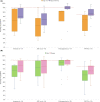Evidence of sociodemographic heterogeneity across the HIV treatment cascade and progress towards 90-90-90 in sub-Saharan Africa - a systematic review and meta-analysis
- PMID: 32153117
- PMCID: PMC7062634
- DOI: 10.1002/jia2.25470
Evidence of sociodemographic heterogeneity across the HIV treatment cascade and progress towards 90-90-90 in sub-Saharan Africa - a systematic review and meta-analysis
Abstract
Introduction: Heterogeneity of sociodemographics and risk behaviours across the HIV treatment cascade could influence the public health impact of universal ART in sub-Saharan Africa if those not virologically suppressed are more likely to be part of a risk group contributing to onward infections. Sociodemographic and risk heterogeneity across the treatment cascade has not yet been comprehensively described or quantified and we seek to systematically review and synthesize research on this topic among adults in Africa.
Methods: We conducted a systematic review of peer-reviewed literature in Embase and MEDLINE databases as well as grey literature sources published in English between 2014 and 2018. We included studies that included people living with HIV (PLHIV) aged ≥15 years, and reported a 90-90-90 outcome: awareness of HIV-positive status, ART use among those diagnosed or viral suppression among those on ART. We summarized measures of association between sociodemographics, within each outcome, and as a composite measure of population-wide viral suppression.
Results and discussion: From 3533 screened titles, we extracted data from 92 studies (50 peer-reviewed, 42 grey sources). Of included studies, 32 reported on awareness, 53 on ART use, 32 on viral suppression and 23 on population-wide viral suppression. The majority of studies were conducted in South Africa, Uganda, and Malawi and reported data for age and gender. When stratified, PLHIV ages 15 to 24 years had lower median achievement of the treatment cascade (60-49-81), as compared to PLHIV ≥25 years (70-63-91). Men also had lower median achievement of the treatment cascade (66-72-85), compared to women (79-76-89). For population-wide viral suppression, women aged ≥45 years had achieved the 73% target, while the lowest medians were among 15- to 24-year-old men (37%) and women (49%).
Conclusions: Considerable heterogeneity exists by age and gender for achieving the HIV 90-90-90 treatment goals. These results may inform delivery of HIV testing and treatment in sub-Saharan Africa, as targeting youth and men could be a strategic way to maximize the population-level impact of ART.
Keywords: 90-90-90; HIV testing; antiretroviral treatment; cascade; sub-Saharan Africa; sustained virologic response.
© 2020 The Authors. Journal of the International AIDS Society published by John Wiley & Sons Ltd on behalf of the International AIDS Society.
Figures





References
-
- The UN Joint Programme on HIV/AIDS (UNAIDS) . 90‐90‐90: an ambitious treatment target to help end the AIDS epidemic, 2014. Geneva, Switzerland: UN Joint Programme on HIV/AIDS (UNAIDS); 2014.
-
- The World Health Organization . Guideline on when to start antiretroviral therapy and pre‐exposure prophylaxis for HIV. Geneva, Switzerland: The World Health Organization; 2015. - PubMed
-
- The UN Joint Programme on HIV/AIDS (UNAIDS) . Prevention gap report|UNAIDS. Geneva, Switzerland: UN Joint Programme on HIV/AIDS (UNAIDS); 2016.
-
- Havlir D. SEARCH community cluster randomized study of HIV “test and treat” using multi‐disease approach and streamlined care in rural Uganda and Kenya In: Proceedings of the 2018 International AIDS Conference. Amsterdam, Netherlands: International AIDS Society; 2018.
-
- Makhema J. Impact of prevention and treatment interventions on population HIV incidence: Primary results of the community‐randomized Ya Tsie Botswana prevention project In: Proceedings of the 2018 International AIDS Conference. Amsterdam, Netherlands: International AIDS Society; 2018.
Publication types
MeSH terms
LinkOut - more resources
Full Text Sources
Medical

